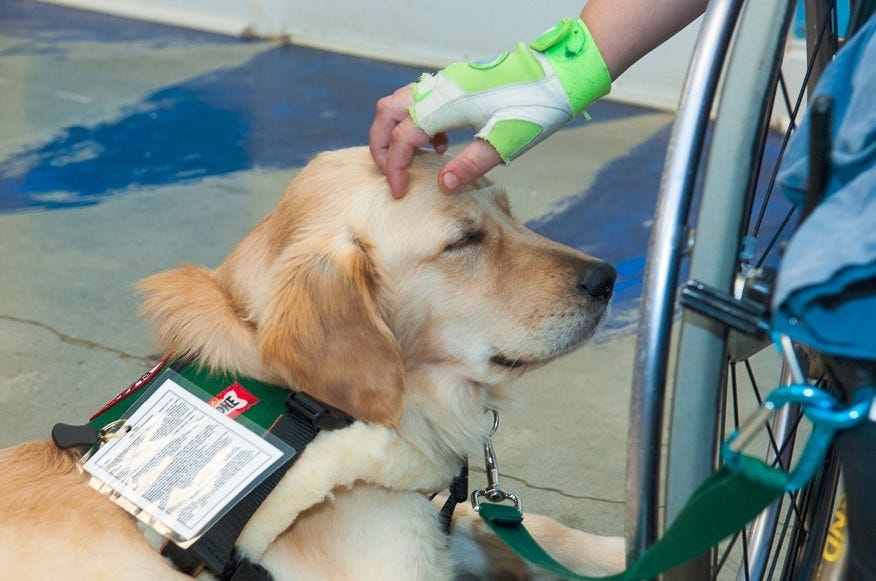PU Proves Service Dogs Impact Handlers’ Psyche
 Scientific evidence of a service dog's impact could persuade insurance companies to begin covering the cost
Scientific evidence of a service dog's impact could persuade insurance companies to begin covering the cost
Subscriber Benefit
As a subscriber you can listen to articles at work, in the car, or while you work out. Subscribe Now“Service dog” is the official name for the four-legged companion that assists a handler who has a physical disability—but many would argue best friend, companion or lifesaver are more accurate terms. However, the animals’ positive impact is only anecdotal and lacks validity in the world of science. Scientists at a Purdue University center say their recent study generates detailed data about how service dogs change handlers’ lives—which could validate the dogs’ impact and fetch support to expand their use.
“The field of human-animal interaction has relied on anecdotes to guide us. ‘My dog makes me feel good’ is meaningful, but there really isn’t an empirical quantification of what that means,” says Kerri Rodriguez, a graduate researcher at the Center for the Human-Animal Bond in Purdue’s College of Veterinary Medicine. “I’m excited that we’re really putting strong science behind something that we know intuitively—but science hasn’t caught up to quantifying yet.”
While earlier research at the center examined the impact of service dogs for people with post-traumatic stress disorder (PTSD), this particular study focused on people with physical disabilities. Rodriguez, who was the lead researcher, says service dogs are directly trained for daily tasks to assist people with conditions such as cerebral palsy, muscular dystrophy and epilepsy—but the data proves the animals also impact the handlers’ psychosocial health.
The project, also led by Purdue Assistant Professor of Human-Animal Interaction Dr. Maggie O’Haire, compared 154 people throughout the U.S.; some had a service dog, and the remaining participants were on the waiting list to receive a service dog.
“This [topic] is important to quantify, because individuals with physical disabilities…experience quite a bit of social isolation and difficulty in social interactions,” says Rodriguez. “They’re also subject to higher levels of depression, as well as low self-esteem or confidence. It’s important to look at how a dog may affect these very important disadvantages they may have.”
The study revealed that people with a service dog had better overall psychological and social functioning, including higher emotional functioning and better work/school functioning. Such evidence could, for example, persuade insurance companies to begin covering the cost of a service dog, which can be upwards of $25,000.
However, the data also showed that service dogs did not impact other indicators of well-being, including anger, sleep quality and social companionship.
“That was, in some ways, surprising, but also helps us hone in on areas of life a dog can impact and where they may not. We don’t expect a service dog can cure everything,” says Rodriguez. “For social companionship, having a dog with you may help with short-term or more casual social interaction—you receive more smiles or people talk to you in public—but it may not translate to deep, meaningful social relationships.”
Looking at another aspect of service dogs, the team is currently analyzing data from its study of facility dogs—specifically, resident therapy dogs at children’s hospitals; different from animals that visit sporadically, these are dogs have a daily, long-term presence.
Evidence of facility dogs’ impact on young patients already exists; instead, the Purdue team is analyzing the dogs’ effect on hospital employees.
“[We’re looking at] job satisfaction and unit cohesion among nurses, doctors and staff. And burnout, which we know is a big problem…especially in pediatric cancer units, for example, where there’s a lot of emotional stress,” says Rodriguez. “Presumably, the handler—a child life specialist—is forming a very strong bond with their dog, bringing it to work every day to benefit the patient—not necessarily themselves. But anecdotally, we know [the dogs] are impacting their lives in different ways.”
Both studies support the center’s overarching goal to sniff out the science behind human-animal bonds—generating the data that science demands, says Rodriguez, but handlers’ hearts already know.
Rodriguez says studies involving service dogs can relate more broadly to a traditional pet dog.
Rodriguez describes how the study produced “strong science” to show service dogs’ effect on handlers’ wellbeing.
